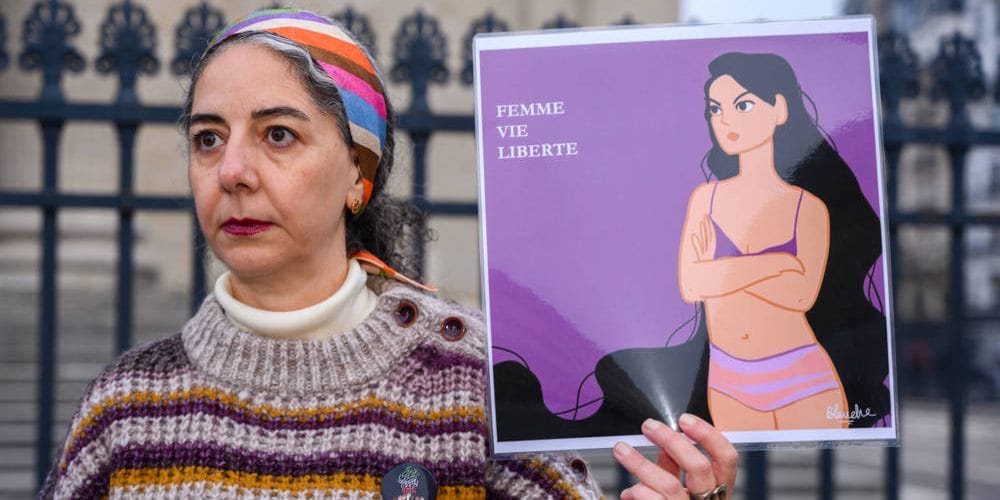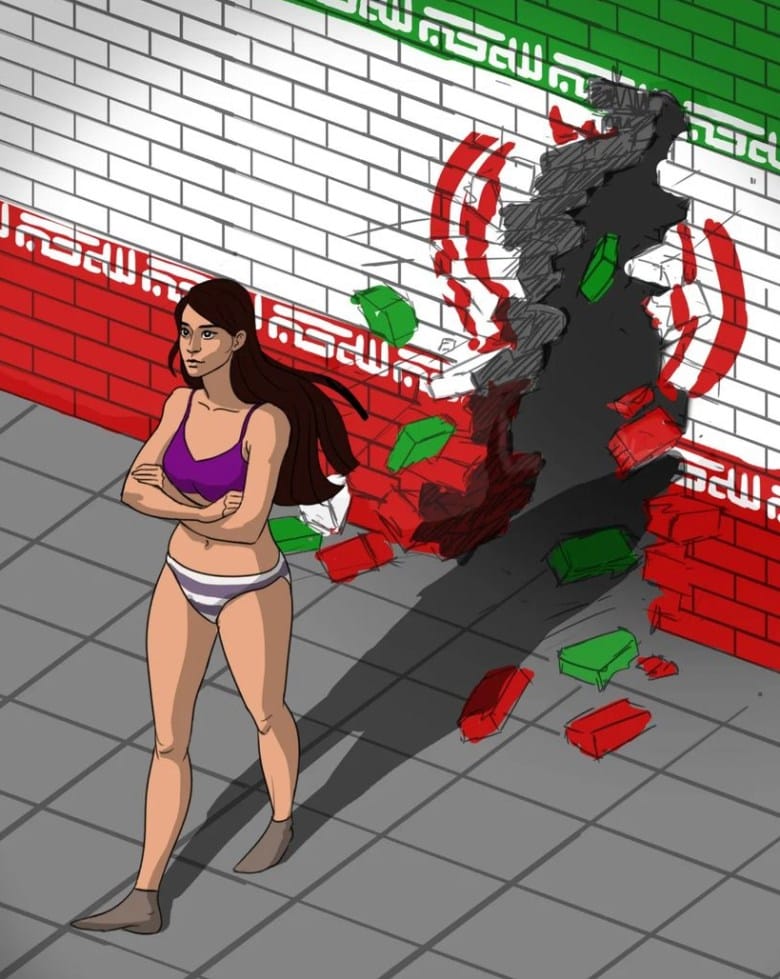It has been more than two years since the death of Mahsa Amini, a young college student who sparked a ‘women led uprising‘ in Iran in 2022. Amini had died in police custody after being arrested for allegedly not wearing the veil appropriately. Women of Iran have been fighting for their bodily autonomy against a repressive state for decades and this resistance has once again come to the front.
On November 2, 2024, a video went viral showing an Iranian female student disrobing in protest against the morality police’s coercive enforcement of a strict dress code.
On November 2, 2024, a video went viral showing an Iranian female student disrobing in protest against the morality police’s coercive enforcement of a strict dress code. Identified as Ahoo Daryaei from Tehran’s Islamic Azad University, the young woman has become the latest symbol of this resistance against a system deep rooted in gender discrimination. In the bold stance of defiance, Ahoo Daryaei stripped to her underwear after being confronted by university security for not wearing a veil. She was immediately taken into custody and escorted to a psychiatric facility, as reported in Iranian media.
The video of her protest has refreshed the memories of the “Woman, Life, Freedom” protests of 2022-23. The visuals of defiance of school and college girls rising up against the state imposition of dress code chanting ‘Jin, Jiyan, Azadî‘ (Women, Life, Freedom) – a slogan of Iranian women’s struggle for autonomy – captivated the imagination of people fighting against gender injustice across the world.
The fire ignited by the women protestors had engulfed the capital Tehran and Kurdish speaking region of the country. Clerical tyranny almost came to the brink of a collapse that September. The aspirations of the Iranian women, fighting in the streets for their freedom inspired millions around the world. The revolutionary slogan became a worldwide phenomenon to shackle the chains of patriarchy. Three simple words became an embodiment of the global fight against various types of state discrimination. When Tehran was breathing in the air of freedom, it caught the imaginations of Indians too, in their fight against a discriminatory majoritarian government to defend their long-cherished civil liberties.
Tyranny of morality – in Iran and everywhere in the world
The Ahoo Daryaei incident is part of an ongoing resistance against strict dress codes in Iran which makes veiling for women mandatory. The role of the “morality police” has always been a thorn in the eyes of many young women. In 2022, the anger of young women protesters burst out at the infamous ‘guidance patrols’. Its arbitrary enforcement of dress code was the ultimate symbol of oppression for the protestors.
The Morality Police’ violent treatment of women too was not lost on their mind. Despite the intensified clampdown on dissent, Iranians are questioning the regime and demanding an end to compulsory veiling. Women’s bodies have always been a ‘battleground of morality’ to be controlled and conquered for the religious fundamentalists across the world. In recent years, parallels can be drawn between clerical theocracy of Iran and Hindutva ethno-nationalism as how women become the primary target whenever a political ideology embedded in religion takes the power and the country is handed over to religious extremists.
Institutionalised violence becomes a weapon to impose majoritarian homogeneity. Be it the Evangelical Christian movement in the United States, attempting to crush the abortion and trans rights or Hindutva ideology in India, these examples are part of the global phenomenon which has displayed time and again that the political appropriation of religion by populist extremist forces is inherently repressive for women and other people left on political margins and can relegate them to second class citizenry.
When robbed of justice, disrobing becomes an act of protest
Naked protests have for long been a part of women’ fight against the exploitation, harassment and even colonial subjugation across the world. Women have displayed the naked body in the patriarchal public sphere for varied political demands (often relegated to the rugs by the political structure) – against sexual violence, protecting the indigenous land and rights and seek economic justice.
These protests, part of the Body Politics movement, are inspired by the feminist ideals of equality and social justice.
These protests, part of the Body Politics movement, are inspired by the feminist ideals of equality and social justice. They have given a language of assertion to the oppressed women to express themselves across the globe. In these protests, a naked body defies and mocks the patriarchal norm in which nakedness – especially female nakedness – is disapproved and shamed by the society.
In July 2004, the fury over the killing of a woman Manorama Thangjam by the Indian armed forces led to the naked protest by 12 Manipuri women in Imphal. The local women who felt robbed of the justice by the systemic impunity possessed by the military found no alternative better than disrobing their clothes, shaming the perpetrators and carrying banners with slogans painted in red in a heart-wrenching site. The bullet pierced body of Manorama was found in a paddy field. The protest widely covered by media outlets opened the plight of Manipur people and – particularly of women – to the eyes of the world.
Naked protests have been a powerful tool for women in Sub-Saharan Africa to seek change and fight their systemic colonial oppression. The courageous act of Ahoo Daryaei can be seen having some resemblance to these protests where a woman in an unjust system – which has deprived women of their agency – takes it to the street to assert her identity and disrobes herself. By using the subversive nakedness as a flag of defiance, women use their bodies to show unwillingness to be subjugated and thwart the oppression going on in the plain sight but still invisible.
By using the subversive nakedness as a flag of defiance, women use their bodies to show unwillingness to be subjugated and thwart the oppression going on in the plain sight but still invisible.
Women disrupt this overarching patriarchal control and the normalising of it by disobeying the very cultural norms that are at the heart of it. Disrobing of one’s clothes at public places possesses the power of turning vulnerability into defiance and challenges what has been just accepted as a norm.
The body as a site of resistance
The body can be described as an active agent in the social environment we live in since we function in it only through the body (Vance). Not only cultural values surrounding us reflect themselves through the body but the body also responds, cultivates and challenges those very social norms. And this mutual interplay is what that shapes our relationship with our world. The anthropologist Claudine Cassar says, when a human body will become subject to social control, domination, the body can become an effective weapon of resistance.
Thus, clearly, feminism in that sense is a resistance movement in which women have historically used their body to resist such subjugation. The feminist movement in its history has been built around and intersected with the larger fight against the exploitative capitalism, racism and ethnic privilege, heterosexism and ableism.
When Nigerian women in 1929 marched naked and lay on the ground waving their legs to shame the authorities in opposition to the imposing of taxation on women’s property, they displayed a show of solidarity against a repressive colonial rule. The daring collective action did fruition – afraid of protests getting bigger, the colonial administration revoked the tax.
Nakedness deployed effectively for political ends by women has a long history across sub-Saharan Africa. Women have gone topless, exposed their genitals and stripped in public in order to challenge male power and disrupt gender relations in post-colonial Africa. When #FeesMustFall (FMF) protests broke out at South Africa’s campuses in 2016-17 calling out the institutionalised racism, feminist activists put forward their naked bodies to shame the domination of men on public arena. the FMF protest was a remarkable example of how naked protests has the ability of disrupting the patriarchal public sphere and have been deployed as an empowering tool to defy men and authorities in violent conflicts.
As feminist historian Wendy Harcourt has put it ‘Body politics disrupts normative gender presumptions in a negotiation of power via the body, both directly and through visual representation.‘ In the act of disrobing, the female body speaks a language of assertion and power, hence demanding the transformation of the male dominated political reality. Naked protests are part of current and emerging forms of feminist body politics, where people use their bodies as intimate vehicles of protest against power, challenging cultural, economic and social practices. Women in naked protests, rendered voiceless by mainstream politics, write their own political statements forcing men in authority to feel shame and refusing from being neglected and being buried on the margins of history.
Vivid examples of feminist body politics have displayed that women and people of other genders found an expression and an effective tool of their bodies to unsettle the gendered binary prevalent in the society and eventually transform the whole cultural landscape.








